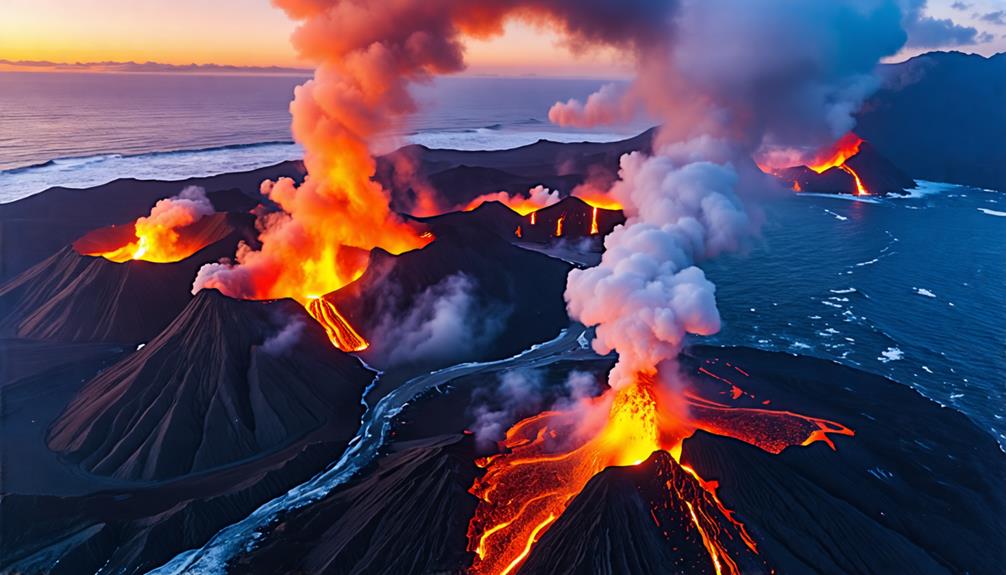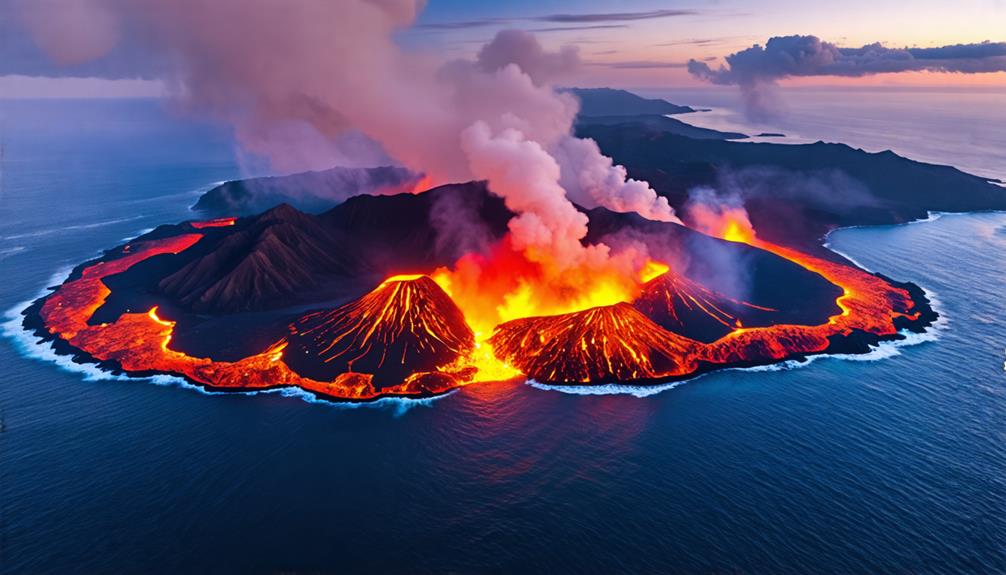You've likely heard of the Ring of Fire, but did you know it's home to three-quarters of Earth's volcanoes? This horseshoe-shaped zone encircling the Pacific Ocean is a hotbed of geological activity. It's where tectonic plates collide, creating a perfect environment for volcanic eruptions and earthquakes. The sheer concentration of volcanoes in this region raises intriguing questions about Earth's inner workings and the forces that shape our planet's surface. As you consider the implications of this volcanic hub, you might wonder: what does it mean for the millions of people living in its shadow?
Key Takeaways
- The Ring of Fire hosts approximately 75% of Earth's active and dormant volcanoes due to extensive tectonic plate interactions.
- Convergent boundaries and subduction zones along the Ring of Fire are primarily responsible for the high concentration of volcanoes.
- The Pacific Plate's interactions with surrounding plates create conditions favorable for magma generation and volcanic activity.
- Volcanic eruptions in this region can produce various hazards, including ashfall, pyroclastic flows, and lava flows.
Tectonic Forces Shaping the Ring

The Pacific's Ring of Fire owes its fiery existence to a complex dance of tectonic plates, constantly pushing, pulling, and grinding against each other.
You'll find that the Ring of Fire's volcanic activity and earthquakes are primarily driven by the interactions of several tectonic plates, including the Pacific, North American, Eurasian, and Nazca plates.
Convergent boundaries dominate this region, creating subduction zones where one plate dives beneath another. This process forms deep ocean trenches and volcanic arcs along the Pacific Ocean's rim.
For instance, the Aleutian Trench, reaching depths of 7,679 meters, is a result of the Pacific Plate subducting beneath the North American Plate.
As plates subduct, they melt, generating magma that rises to the surface, causing volcanic eruptions.
These tectonic forces shape the Ring of Fire's dynamic landscape and contribute to its frequent seismic events.
Volcanic Hotspots and Hazards
While tectonic forces shape the Ring of Fire's overall structure, you'll find that volcanic hotspots and their associated hazards add another layer of complexity to this geologically active region.
The Ring of Fire, home to about 75% of Earth's volcanoes, is primarily characterized by subduction zones. These zones, where tectonic plates collide, are responsible for most of the volcanic activity and hazards in the Pacific Ocean region.
However, hotspots like Hawaii, which aren't related to plate boundaries, contribute to the area's geological diversity.
You'll encounter different types of hazards depending on the volcano's origin. In the Ring of Fire, subduction-related eruptions often produce ashfall, pyroclastic flows, and lava flows.
While hotspots can create new landforms over time, they generally pose less immediate danger than the active volcanoes along the Ring's subduction zones.
Monitoring and Research Efforts

Scientists and researchers employ cutting-edge technology to monitor and study the volatile volcanic activity along the Ring of Fire, enhancing our understanding of these geological phenomena and improving public safety.
You'll find seismographs and satellite systems tracking volcanoes like Popocatépetl in Mexico, evaluating hazards such as ashfall and pyroclastic flows. These monitoring efforts provide essential data for local communities, helping them prepare for potential disasters.
The National Geographic Society supports research through grants and educational resources, focusing on the Pacific Ocean's tectonic activity.
Collaborative international initiatives are key to understanding plate interactions and their impact on earthquakes and eruptions. Ongoing geological research is particularly important in high-risk areas like Japan, which experiences about 10% of the world's volcanic activity.
Conclusion
You've discovered the fiery heart of Earth's volcanic activity. The Ring of Fire's tectonic dance shapes our planet's surface, creating both beauty and danger.
As you explore this region, remember the immense power beneath your feet. Stay informed about volcanic hazards and support ongoing research efforts.
Your understanding of the Ring of Fire connects you to Earth's dynamic nature and the importance of global geological awareness.

Leave a Reply